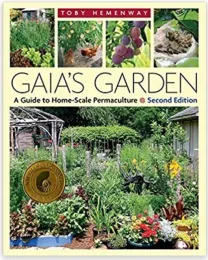
GAIA'S GARDEN: A Guide to Home-Scale Permaculture, Second Edition
Toby Hemenway, Chelsea Green Publishing, White River Junction, Vermont, (2000 First Edition) 2009, 313 pages.
Nature exists with or without us. We do not exist without the bounty that nature provides to sustain us. As a matter of fact, we manipulate our environment to be able to make it work for us. We can make choices in how we provide for ourselves and manage our place in nature. Permaculture is an approach or a set of choices we can make that is ecological and productive.
Although the term PERMACULTURE was not widely known even twenty years ago, the basic gardening practices that are a part of this sustainable life philosophy was realized and adapted from practices of indigenous peoples and historic farming practices in different parts of the world. The philosophy encompasses a life focus and mind set that emphasizes becoming a part of and sustaining life realistically in a greater ecological network with the plants, animals and resources in the environment around you. In GAIA'S GARDEN, Toby Hemenway describes and supports the pursuit and implementation of very practical methods to achieve a sustainable, healthy, productive and edible habitat with sound, ecological gardening and design processes. He does it in a systematic, well detailed conversation of principles and goals emphasizing observation, problem solving, conservation of materials and effort, and working with a greater sensitivity to the multiple layers of relationships that change or evolve over time in the natural environment where you garden and live. We see how doing no harm, using only what you need and is available while sustaining productivity is consistent and desirable with activity that embraces the surrounding ecological network that feeds us. It is possible that we live well and simultaneously protect our planet.
For example, let us discuss the plant guild system. It is one of the fundamental processes in food production techniques in permaculture methods. The plant guild is a construct that creates a plant community for food production in a “mutually supportive” collection of plants, animals, insects, and natural relationships and processes. A successful guild can be defined as a habitat where soil health, water availability, sun exposure, beneficial insects such as pollinators, fungi, birds, plants, trees, and people, etc., exist harmoniously and receive all they need to maintain themselves over time and contribute to the well being of all other partners in the guild. One well-known plant guild example of ancient origin is the Three Sisters guild that involves planting in the same space, corn, squash or pumpkin and beans. Simply but not completely described: The bean has nitrogen fixing bacteria filled root nodules that feeds the corn and squash who have a high need for nitrogen to develop. The corn can provide a trellis for the bean plants to grow and the squash and pumpkin can shade the soil with their broad leaves to conserve moisture. In concert, they maximize the benefits for each other.
The plant guild is not a rigid system or set collection of plants. It is an adaptation of diet options, climate, weather, water, soil and sun conditions and plants, shrubs, trees that work locally. Work they all do to create and maintain healthy soils, water, provide nutritious foods including chickens, etc., habit to harbor beneficial insects, birds, animals, in cooperation with nature and natural processes. Different environments succeed with combinations suited to conditions and needs on site. It is an organic and a dynamic process but is not limited to native plants and trees. It takes advantage of the natural habitat and what it provides but is pragmatic in providing the many foods and other resources, exotic or native, that we need to sustain our lives as humans. The method is superimposed on the natural world and incorporates the adaptations made by plant, insect and animal participants to their changing environment.
Designing and creating our gardens to provide, sustain and adapt over time is part of Hemenway's presentation. First, knowledge and utilization of the basic principles of growth and production is necessary. Learning from others and direct experience and observation about soil health, water use, collection, and management, plant, shrub, and tree knowledge, ecological principles of biodiversity, regeneration and recycling of nutrients, minerals and resources, encouragement and nurturing of beneficial insects, animals and the other operational layers are fundamental to success in having a working and fruitful garden. Many factors contribute and interact for success. Complicated but possible.
Then, what plants, processes, devices and goals are necessary for success? How can I have greens to eat all year? How will chickens be healthy and happy so I might have eggs? How can enough water be available without rain? On and on, layer upon layer. Combining all these elements for maximum function and success becomes design. Organizing the space available using the principles in GAIA'S GARDEN like guilds, food forests, stacking, keyhole gardens, square foot gardening, espalier, trellis, acreage in the country, a parking strip in the city all are valid opportunities to create a permaculture garden that functions and satisfies.
In GAIA'S GARDEN, Hemenway brings us a great distance in showing us this way. Straightforward talk, charts, diagrams, pictures, science, real working examples and down to earth answers and solutions help to make a complex, richly textured, multilayered, intricately woven process for gardening well, naturally and sustainably possible. This book provides a learning experience that serves you well no matter what kind of gardening you do. You will have so many more things to learn and so many more ways to see what happens in the garden around you.

